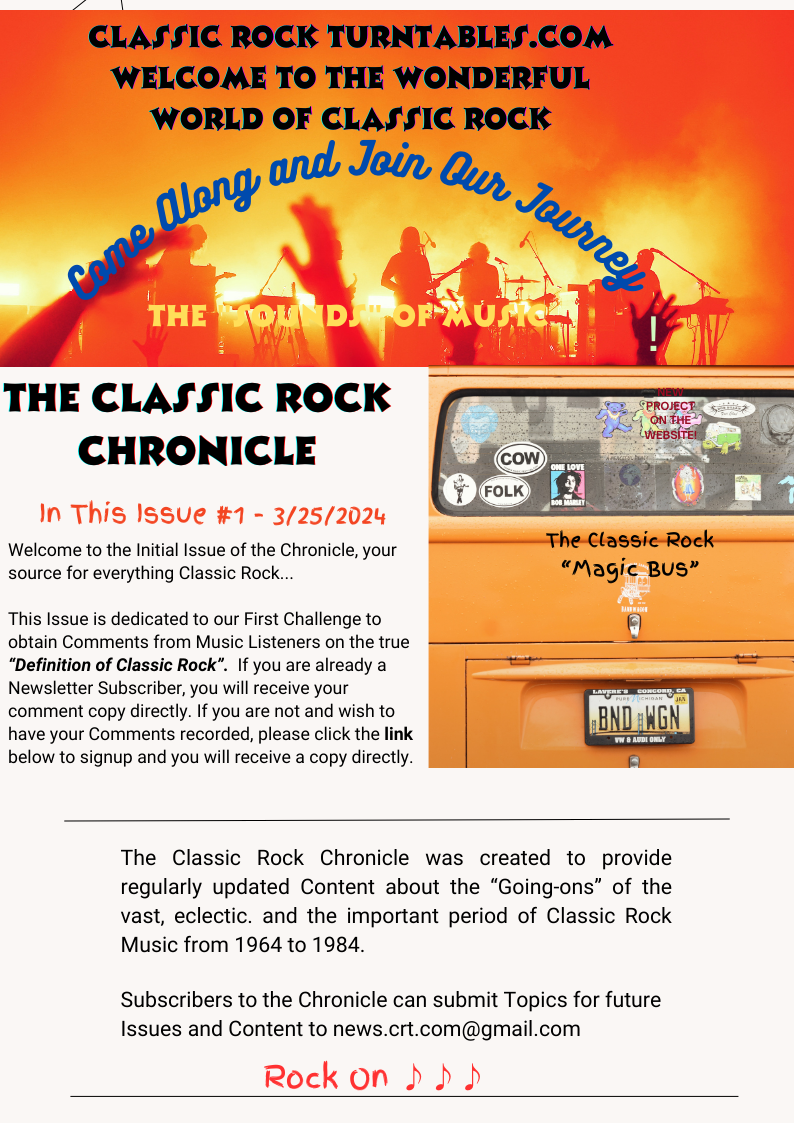

I want to give my "Heartfelt" thanks to all my Friends who have supported my Journey to create a Worldwide Community of fellow CRockers... we now have a true cross-section of Music lovers, Musicians, Producers, Singers, Composers, and knowledgeable Listeners... a BIG OORAH!
I want to introduce our newest Friends, the Victory Youth Foundation Africa whose goal is to use Music to enhance the lives of young people. My new Friend, Abdul Noor, is leading the cause to build a recording Studio to show the talents of his Group to the World... I will work hard to use Classic Rock Music as the genesis of their future... be it Blues/Jazz (Blazz) Rock, Folk, Country, and R&B.
I will do everything in my power, with your support, to make this noble cause a success.
Thank you ALL... Willie Rock On ♪♪♪
The Classic Rock Chronicle
I Issue #5 May 5, 2024
Everything Classic Rock... the CRocker's Voice
Issue #5 - A Tribute to Satana - Cinco de Mayo is a yearly celebration held on May 5 to commemorate Mexico's victory over the Second French Empire at the Battle of Puebla in 1862
Issue #6 - The J. Giles Blues Band... Boston
Issue #8 - Willie's Top 10 Classic Rock Bands
2024 is the 55th Anniversary of Woodstock and I am in the mood to recount some of my great memories of that year... to me, 69 was just as important, or more, than 64 in the evolution of the Rock n Roll Genre. The British Revolution was upon us and the reaction to the Ed Sullivan Show watchers (73 million) was mixed, to say the least. It was the first time Parents saw the effects of "Groupies" and became openly against what they felt was coming... intolerable Sounds that were going to ruin the likes of the day's Youth.
It took 5 years for hip Promoters (John Roberts, Joel Rosenman, Artie Kornfeld, and Michael Lang (the planner of the relatively successful Miami Pop Festival in 68) to stage an event not likely ever to happen again in its form... it remains the Touchstone event that has successfully been copied in the Modern Music era. This was not just a Rock Concert as there were Folk Artists (Joan Baez and Arlo Guthry), Blues Rock Artists (Janis Joplin, Johnny Winter, and the Paul Butterfield Blues Band), Jazz Rock Artists (Santana and Blood, Sweat and Tears), the versatile Crosby, Stills, Nash, and Young, the Prog Rock Boston Band Quill, and the amazing Ravi Shankar, the renowned Indian Sitar player representing the global musical influences who wowed the diverse Audience.
It was much more than a gathering of Artists, Fans, and Hogs and Mud... it was a transformative moment that changed the Music Industry forever. It helped to significantly redefine American Culture and became synonymous with the worldwide Hippie movement... Hippies rejected the mainstream values of Consumerism, Materialism, and the pursuit of Individual Success. Instead, WE championed values of Love, Unity, and Cultural Revolution against the Establishment. Woodstock became a manifestation of these ideals, drawing hundreds of thousands of like-minded individuals who would carry the Theme of the 3-day event home to pass on the love to the Masses.
With that said, It has been a long wait for me to "spill my beans" about my Passion for the results that Woodstock 69 created for Modern Music... My journey to August 15, 1969, started in January with the Boston Tea Party Concert by Led Zepplin... that Concert is regarded as one of the Top Rock Concerts with an amazing Audience participation... and indeed the 4 hr+ event is one never forgotten, as I was there, and my appreciation for what was happening to Rock's evolution!
I had gotten my first glimpse of the Boston Music Scene from my Best Friend, Butch, who graduated with me from The Wisconsin School of Electronics in 1965... and the Drummer in my Band, Bevo, who was really into the happenings there. I remember when he called me in 67 after seeing the Doors at the Crosstown Bus Venue in Brighton (before it closed) with "Hippie "Go-G0" Girls and aluminum foil reflecting walls for the Psyc strobing lights... a sight to behold, indeed. "You need to get your boney arse out here, Mate."
Boston in 1969 was a key City for Wannabee Bands trying to get attention after their experiences opening in New York... there were dozens of Garage Bands, many of which never were recorded. The Underground Scene in Boston began in Cambridge where the "Folk Boom" began with the College Students' tastes... then along came Club 47 which was originally a Jazz Club... then the Jim Kweskin Jug Band introduced Jug Band music to America... and so on (this will all be covered in detail in Issue #7)
Enough said as the Stage is set for the miracle year of 1969... Starting in January 1967, the Boston Tea Party held 25 Concerts before it was discovered by the Velvet Underground... then along came Canned Heat and one Richie Havens (who opened Woodstock), then Muddy Waters, Steve Miller Band, B.B. King, Procol Harem, Quill (Woodstock), John Lee Hooker, Van Morrison Controversy, Jeff Beck Group, J. Geils Blues Band, and then led Zeppelin in January 69 (Issue #3). My point in all this is that the Boston Scene was a precursor to Woodstock, don't ya know!
In Part #3 of my Tribute to Santana, I will cover his Set, along with Grand Funk Railroad, on October 15, 1969, at the bequest of my friend Butch who called me the night of the 13th after their first Boston Gig to get my arse out there... I thought Santana was f''ing awesome at Woodstock but this was out-of-this-world at the small, acoustical, magical Boston Tea Party.
So, we begin Part #1 of my Fav Spanish Classic Rock Band in Issue #5 of Chronicle Newsletters that will cover Santana's early years up to 1966 where he formed his first real band as the lead...
The Classic Rock Chronicle was created to provide regularly updated Content about the "Goings-on" of the vast, eclectic, and important period of Classic Rock from 1964 to 1984... Come along and enjoy the ride, Mates HOORAH Rock On ♪♪♪
Subscribers to The Chronicle can submit Topics for future Issues and Content to news@classicrockturntables.com
A Tribute to Santana... on Cinco de Mayo
Carlos Santana... the Early Years
In this 3-part Series, we cover the following:
Part#1 - Santana's early years up to and including 1966 where he formed his first official Band, the "Santana Blues Band"
Part #2 - The "California Sound" and the part relating to San Francisco's beat and the Road to Woodstock.
Part#3 - Woodstock and beyond... The making of the "King of Spanish Classic Rock"
Introduction This Tale is adapted from Santana's Biography "The Universal Tone" Bringing My Story to Life
Santana was born Carlos Augusto Alves Santana on July 20, 1947, to José and Josefina
Santana with 2 older Brothers and 4 Sisters. Carlos grew up in Autlán de Novarro, a tiny
mountainous Town between Puerto Vallarta and Guadalajara. It was a throwback to the
past, with Donkeys and Chickens running wild on dirt tracks. The Houses were made of
stone and dried mud, and there was no electricity or running water... but Music was
everywhere, and learning it was as mandatory as learning how to speak by all Children.
Despite facing much hardship in his life, as his Father was gone most of his early life,
Josefina kept the Troops in line with strict discipline. There was not much affection between them as she knew he
was a Man-about-town and loved the Ladies. Mom ruled their Roost and was their disciplinarian, but was not the
"huggy-bunny" type.
Carlos always felt a special connection to his Father, José, who would take him on the back of his bicycle to
watch his singing performances in Church. “My father infected me with the virus of music,” said Carlos. “I saw
how the people were looking at him. All I ever wanted was to be adored the way people adored my Father in
this little town.”
In 1954, José went North to Tijuana far away from their Village to play Mariachi for American Tourists. He
promised his Wife, Josefina, that he would send for the Family when he had saved enough money. But when he
didn’t do so after a year, she suspected that he was cheating on her, which he was. So, in August 1955, she
persuaded one of José’s friends to drive her and her six children to Tijuana, promising that José would pay him
when they got there. Then, Josefina sold all their furniture to raise gas money for the 1,500-mile journey.
When Josefina knocked on the door of the return address of José letters, she was not surprised when a Young
Woman answered... "No one here by that name," she said. As Josefina sadly walked back to the car, an old man
who had been sitting on the sidewalk watching everything asked who she was looking for.
“José Santana,” replied Josefina.
“Yeah, he’s inside. Are you guys his family?” said the man. “Knock again. He’ll come out.”
José came out and started screaming at Josefina for daring to bring the children to Tijuana without his
permission. When he finally calmed down, he drove them to one of the town’s worst slums, dropping them off at a
house without any windows or roof. Then he drove off, leaving them there to fend for themselves. For the next
two months, Josefina and the Children struggled to survive in the slums. Twice a week José would suddenly
appear with two bags of groceries for his family, before disappearing again.
Eventually, there was a reconciliation, José left his Mistress and moved them into his house. Then he sent Carlos
and his younger Brother, Jorge, out to hustle the tourists on Tijuana’s main drag, Avenida Revolucion. Dressed in
colorful mariachi suits, the two small boys would perform old Mexican folk songs, such as “Mexicali Rose” and “La
Paloma” for 50c a song... while selling snacks to Tourists.
In 1956, José moved his family into a better Tijuana neighborhood, enrolling Carlos in the Miguel F. Martinez
School of Music, where his Teachers wanted him to learn Clarinet... Carlos refused, sticking to
the violin instead. José moved from the small village to the border town of Tijuana and formed a touring Mariachi band called Los Cardinales.
In 1957, Carlos, now 10, joined his Father’s Mariachi Band, Los
Cardinales. They played in some of the seediest Bars and Night Clubs
on the backstreets of Tijuana, as well as a low-class Bordello. Carlos
experienced the crude, drunken behavior ofthe Customers toward the
Prostitutes, who would Mother him, and molest him (kindly)... and he
came to hate the Mariachi Music as it would always remind him of his seedy past
Throughout 1958, Carlos still was playing the Violin and selling
candy in the streets... but his tastes and desires were changing and
he felt stymied by his Father. He was beginning to develop his tastes
for Music... his Mother loved Duke Ellington and he caught the Vibes
that he needed to master.
This all went on until 1959 when José saw his calling to move on to his next venture... so in 1960, José Santana
took off and left his family again. This time he moved to San Francisco, where the earnings were higher for a
Mariachi Musician.... he had a weekly show at La Cantina de los Remedios in nearby Mill Valley.
With his Father gone, Carlos stopped going to Music School, as he disliked practicing the Violin. Then his
perceptive Mother decided to show Carlos that there were other kinds of better Music besides Mariachi. On
Sunday morning she took him to the Palacio de Municipal Park in the middle of Tijuana, where the local Musicians
hung out and played. Walking into the park he first heard the sound of an Electric Blues Guitar with a Boogie kind o
beat and echos bouncing off of trees and buildings.. “That’s when everything just changed in my life,” he said. “It
was like somebody kicked me in the balls, man. It was like a bang!.”
The Blues Musician playing the Guitar was a sharply dressed sixteen-year-old named Javier Batiz, who had a
flyaway pompadour haircut, leather jacket, and razor-pressed khaki pants... and he played the latest hits by Chuck
Berry, B.B. King, Little Richard, Bo Diddley, and Freddy King. Javier Bátiz, known as the “Father of Mexican Rock and
Roll,” has also been given the Spanish nickname, “Brujo del rock” – meaning "Warlock,” from as long as he could remember, he explained.
“I don’t know why… maybe they think I’m a brujo, but I like it – it’s better than being called a cockroach!" he says in
his playful manner. The name makes sense, considering the definition of a “warlock” is “a male practitioner of
magic,” and Bátiz says he’s had a magical talent for playing music on the guitar, piano, saxophone and drums, from
a young age.
Later that day Josefina took Carlos to Batiz’s home and asked Batiz if he would teach her Son to play electric
blues guitar. When Batiz asked Carlos if he played another instrument, he took out his violin and played a tune.
Before they left, Batiz showed Carlos a few chords and runs on the guitar, and by the next day Carlos had mastered
them all.6 (Source)
"Carlos didn’t sleep last night, he was studying,” Batiz recalled. “I taught him one movement and the day after that
he brought me ten movements, different movements. And I went, ‘Wow,’ because he was so hungry to learn the
Blues Guitar.”
The next day, Josefina brought Carlos to see him play his Tuesday night Gig and he was hooked... Batiz taught
Carlos everything he knew and played with him for years. He was also heavily inspired by Music of the Blues
sounds of Elmore James and Little Richard... as Carlos progressed his talents, he was influenced by the American
Pop Music of Ritchie Valens and fell in love with the Blues of B.B. King, Muddy Waters, and John Lee Hooker.
On Friday nights, Carlos started going to see Javier Batiz and his Band the T.J.’s (Tijuanenses) play at the Latino-
Americano club to soak up the Music. He now had little interest in his Catholic parochial School, as he was getting
his musical education on the streets of Tijuana. His fellow School Musicians did not want him around - jealous he guessed.
“I still wasn’t playing,” he said. “I was just sucking up the music and learning.”
The first Song Carlos learned was the Shadows (an English Group) hit instrumental, “Apache,” followed by “Walk
on the Wild Side” by Jimmy Smith and “Peppermint Twist” by Joey Dee and the Starliners.
When Josefina wrote José that Carlos was learning Electric Guitar, he mailed his son an old beat-up Gibson L-5
Guitar, along with one pick, from San Francisco. Carlos was so delighted that he put on nylon strings, not realizing
he needed metal ones since his father had not sent an amplifier. From then on, it was all about Mastering the
Guitar... it was all about "Listening"... and indeed he did!
Next came "Ramble" by Link Wray, "Red River Valley" by Duane Eddy, "Love is Strange" by Mickey and Sylvia, then
he got into Freddie King whose Songs, "San-Ho-Zay", "Ideal Wave", and "Tidal Wave" inspired him. He just plain had
to know those "Licks"!!!
By now, Tijuana was becoming a "Rock n Roll" Venue of all sorts... you could find it best at the Avenida
Revolucion, on the North End, close to the Border in the "Hoity-Toity" Clubs like the "Oasis" and "Shangri-La." Where
great Modern Jazz Quartets at Mike's Bar had dancing was the hottest. It is where he learned the "Peppermint
Twist" by Joey Dee and the Starliners who played the hell out of the Shuffle. Learning these new Licks gave him
more confidence.
Note: By this time, Santana felt himself leaning to the Blues and Jazz (what I call Blazz). He felt the sacredness of
the "Language of Blues" as the best Jazzers understood its history and respected its power... he would Master
the 12 Bars and 3 Chords as in Musical feelings that are expressed in what Notes you play and not just how you
play them. He felt the Blues is a Lake and Jazz was an Ocean... that you had to dive into it quickly recognizing how
deep it could be, masterfully.
In 1961, Josefina Santana filed US Immigration papers for the Family to move to San Francisco, where José was
now making a good living playing Mariachi. She did not want her children to spend the rest of their lives in the
mean streets of Tijuana. Carlos initially resisted the move and stayed behind in Tijuana for another year to
continue working as a Musician.
Carlos was fast gaining a reputation as one of the hottest young Blues Guitarists in Tiajuana. Some friends had
a stack of B.B. King albums, and Carlos started copying them note for note. Then he started learning John Lee
Hooker and Muddy Waters songs to play at the strip clubs.
“They call it cut and shoot music,” said Carlos, “because if they don’t like it
they cut and shoot you.”
He joined a five-piece band called The Strangers, who were rivals of the T.J’s.
He was the youngest member, playing a Kent Electric Bass and calling himself
“El Apache.” The Strangers played dances and small shows, but Carlos was
soon fired for playing too many notes on the Bass.
In late 61, now 14, he was playing all of the time at the Convoy Club playing
Songs by Etta James, Freddy King, and Ray Charles learning new Styles each
Gig. He was in Heaven, he thought, absorbing Licks like a sponge... he was
gaining confidence and how to better take care of himself.
He was then invited to join the House Band on Guitar at El Convoy, one of the biggest Strip Clubs on Avenida
Revolucion. He jumped at the chance, especially since the club provided him with a Fender Stratocaster to play,
along with $9 a week.
“I would start at four o’clock in the afternoon and end at six o’clock in the morning,” said Carlos, “playing one hour
and then watching the Hookers strip for another hour. Six hookers would strip, and then we’d play for an hour. But
you learn a lot, man.”
Carlos was now learning from the many American black musicians, who also played the Tijuana clubs. They
introduced him to soul music, including Junior Walker and The Impressions. But Carlos’s favorite was James
Brown, who was then inventing funk music.
Consumed with music, Carlos never went to school, spending his days on the beach, reading Mad and Hot-rod
Magazines.
In the summer of 1962, the Santana family’s US immigration papers finally came through. José and Josefina
were preparing to move the family to San Francisco’s Mission District when Carlos suddenly announced he was
not going. He was now earning good money at El Convoy, and he felt going to Junior High school in San Francisco
seemed a big step back... but, to no avail as his Mother convinced him while weeping.
During the long drive north to San Francisco, Carlos sulked, refusing to communicate with anybody.
“He was mad,” said his Father “He did not even say a single word during the whole trip.”
And when they arrived at the family’s new home in the Mission District, Carlos locked himself in his bedroom
and refused to eat.
“All he did was cry, cry, and cry,” José said. “He was always mad.”
When José returned to help the family move to America, he expected Carlos to play the Mariachi Clubs with him
again in Mill Valley. But thirteen-year-old Carlos now had his own gig, playing Blues and Top Forty songs with
Javier Batiz in the rundown strip clubs of Avenida Revolucion.
“It was a conflict,” recalled Carlos, “because I was already working . . . playing some real low-life stinky places
where the Prostitutes would be on the corner. When Carlos refused to play Mariachi, his father was furious.”
“It was the first time I stood up to my dad. So he said, ‘OK, pack up you're [guitar]. You’re just like your mother. You
always have to have the last word. Get out of here!
Finally, after three months, Josefina handed Carlos a $20 bill for a bus ticket back to Tijuana, kissing him
goodbye at the bus station. It would be the last time Carlos would see his family for more than a year.
Carlos went straight to the El Convoy Strip Club to try to get his old job back. He walked in to find the House
with the Band playing with a new Guitarist and went up to the bar. Then he handed the manager a note from his
mother, giving her blessing for him to play there, although he was still a minor. The note was crucial, for the Club
knew that the Santana Family had moved to San Francisco, and the Manager would not want Josefina complaining
to the Police about her underage son working there.
The manager told Carlos to leave, but just as he was shooing him out of the door, the owner spotted his favorite
Guitarist and called him over. After reading Josefina’s letter he smiled and walked up to the stage, telling the new
guitarist to go home.
“Carlos is going to take this joint over,” the Owner said.
With nowhere to stay, Carlos was put up by the El Convoy Drummer at his Aunt’s hotel, until they were both
thrown out. Then a family friend came to Carlos’s rescue, renting him a room in his old neighborhood. During the
next year, Carlos had a great time in Tijuana, making good money with his nightly gig at El Convoy.
The Crowd he ran with smoked marijuana in the dark alleys of Tijuana, but Carlos claims he did not start
smoking until several years later in San Francisco. The tall, darkly handsome teenager had the pick of the pretty
Women working the Avenida Revolucion and became close friends with many of them. He was empathetic to the
Strippers and Prostitutes, seeing how tough their lives were.
When Javier Batiz offered Carlos a place in the new Band that he was taking to Mexico City to try to make it big,
Carlos preferred to stay in Tijuana. In early November 1963, Josefina Santana wanted Carlos back in San
Francisco and felt Tijuana was too dangerous for him. So she and her oldest son, Tony, turned up at El Convoy
Club one night unannounced.
“She just kidnapped me,” said Carlos. “She knew I didn’t want to go, so my older brother, who was strong, just
grabbed me and said, ‘Your Mama’s here.’ ” He tried to run away, but his far bigger brother forced him into the car.
Josefina drove them back to San Francisco, where he would remain and a new Career would open up to make his
final Destiny move in San Francisco.
While working as a dishwasher, he witnessed the growth of the Hippie counterculture movement and was
immersed in the exciting political, cultural, and artistic changes that were happening in real time. He often went to
Bill Graham’s Fillmore West where he got the chance to see his idol, B.B. King, perform live and was introduced to
even more musical influences like Jazz and American Folk music
The period from 1963 to 1966 in Carlos' High School years was all about perfecting where he wanted to go in his
Music career... there was no question in his mind about what he was going to do for the rest of his life. It was all
about analyzing the Artists that would influence him the most... before the British Invasion that began in 1964,
along came: The Beach Boys, Chubby Checker, Pete Seeger, Ray Charles, the Kingston Trio, Peter Paul and Mary,
Barbara Streisand, and one Janis Joplin... then, in 1964, along came: Sam Cooke and James Brown, Johnnie Cash,
Bob Dylan, Chuck Berry, Lovin' Spoonful, The Beatles and Dave Clark Five at the Cowpalace. A new Band that
turned him on was a Jug Band called Mother McCree's Uptown Jug Champions before transitioning to Rock with
The Warlocks and then the Grateful Dead in 1965.
In 1965, Carlos played in pick-up Bands at Fraternities (paid in Drugs and Booze) where he met up with one Gregg
Rolie, a lead Singer... their chemistry was instant, and they were both leaning toward something I would call
Blues/Jazz (Blazz) Latin Rock Fusion. Rolie, during the early 60s played in a successful band called William Penn
and His Pals, which was fashioned after Paul Revere and the Raiders.
A friend of Rolie's, one Tom Fraiser, saw Carlos play on a Tuesday night with Mike Carabello (who ended up being
the original Congo player) and two guys from Carlos High School playing bass and drums. They would go to the
Fillmore on Tuesday nights where Bill Graham allowed locals to come
in and play for free just to be there.. Rolie's friend brought Rolie and
Santana together — Santana at the time was working at a Hamburger
Stand in San Francisco's North Beach neighborhood and was interested
in jamming with someone from William Penn and His Pals — and the
two musicians hit it off!
Can you imagine just how fast Carlos' mind was a spinnin'?...
although he was truly entranced by B.B. King, Muddy Waters and
T Bone Walker, he practiced Covering every Song that moved him in
this Music Revolution that was before him. His final decision came in
1966, when he felt following B.B. King was the best place to start his own Band, called "Santana Blues Band".
After discovering Carlos Santana, Bill Graham engineered his meteoric rise to success by insisting that Santana
Blues Band performed at the Woodstock Festival... an Event put on in large part by those who had learned their
craft from Bill at Fillmore East. The name would change to Santana before the Event... but no matter the name, it
was the Sounds and Vocals that put them squarely on the map.
I will end Part 1, "Satana's "Early Years" at this point. Next comes the details of the San Francisco component of
the "California Sound"... a blend of Blazz Fusion, Surf Rock, Folk Rock, and Psychedelic Rock. In Part 2, we cycle
back to 1962 and follow Santana's rise in popularity to 1966 when he formed his own band and beyond towards
Woodstock.
Come along and follow the journey to Woodstock... by the way, Rolie became the lead Singer for the Band,
Journey!
Rock On ♪♪♪

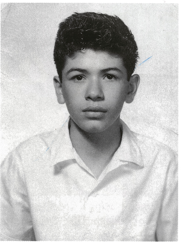
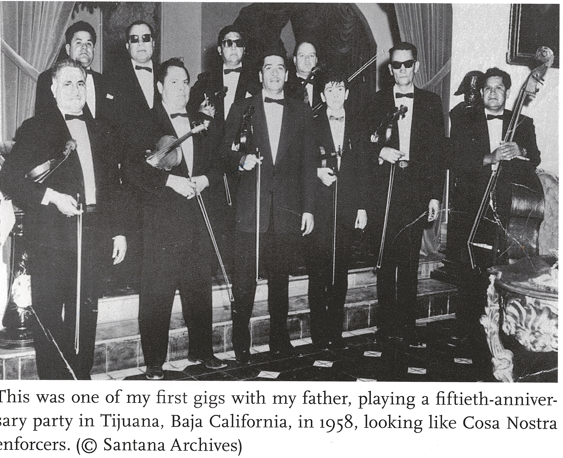

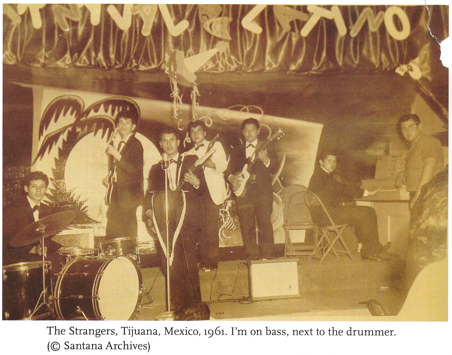

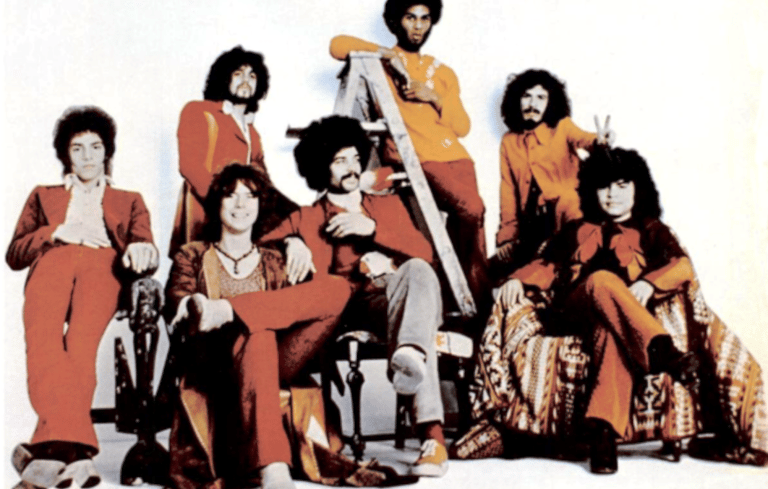

Upcoming Issues of the C hronicle
This a partial list and by no means final... send your request over Messenger on my Facebook page... William W. Nelson
The Woodstock Series
The J. Geils Blues band evolution
The Eagles Series
The Santana Series
The Led Zeppelin Series
The Aerosmith Series
Credence Clearwater Revival
Lynyrd Skynyrd
The Allman Brothers
Blues/Jazz Rock (Blazz) Fusion
The History of Modern Music
Country Rock/Christian Rock/Souther Rock Fusion
Music Theory III (Listening)
How Wannabee Musicians Deal with the Music Industry
The Elements of Good Songs
How to Remaster a Song by Listening
Top 10 and Top 40 All-time Classic Rock Themes (Voting)
The Electric Light Orchestra
George Harrison and the Traveling Wilburys
Eric Clapton
The Guess Who
Steely Dan
Buddy Holly
Chuck Berry and the Influencers of Classic Rock
© ClassicRockTurntables.com
All Rights Reserved
